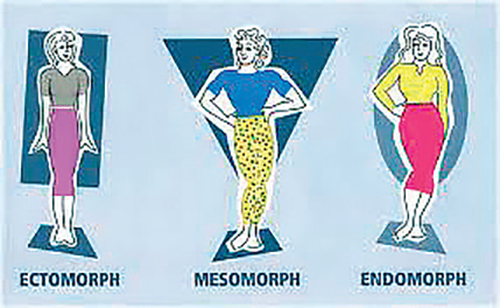

Have you ever wondered why there are some people (and I’m sure you know one or two) who seem to be able to eat whatever they want and not gain any weight? Conversely, perhaps you know others who only have to look at a piece of cake and seem to put on five pounds? Is it just your imagination?
Actually, it isn’t. Contrary to our Declaration of Independence, we’re not all created equal, at least when it comes to body types…
Genetic Variables
There are ten major genetic variables affecting fitness, fat loss, muscle development, and athletic ability including 1) basal metabolic rate (BMR), i.e., the amount of energy (number of calories) you burn at rest just to maintain normal body functions such as breathing, circulation, digestion, thinking, etc.; 2) number of fat cells in your body; 3) limb lengths; 4) joint circumferences; 5) muscle insertions (although the muscles insert onto the same bones in all humans, the exact point of insertion can vary – even a tiny difference in insertion points can create large increases in mechanical advantage); 6) number of muscle fibers; 7) muscle fiber type; 8) digestive capabilities; 9) food allergies and sensitivities; and 10) insulin response and sensitivity to carbohydrates.
Somatotypes
In the 1930s and 1940s, Dr. William H. Sheldon, a Harvard professor, developed a classification system for body types known as somatotyping. He identified three basic body types: ectomorphs, mesomorphs, and endomorphs, although pure body types are very rare; few people are 100% of one body type and 0% of another – usually people are a mix of two or even all three types. However, most people will tend to gravitate towards one type predominantly. Perhaps you can identify your body type(s) in the following descriptions?
Ectomorph
Naturally skinny/wiry; long limbs; small joints, small-boned; small waist, narrow shoulders; angular, projecting bones; naturally lean (low levels of body fat without even working out); often call themselves “hard-gainers”; low strength levels prior to starting a training program; fast metabolism— they burn up everything, even when overeating; don’t store carbohydrates as fat—high carbohydrate diets are ok; high energy levels; tendency to be overactive and restless (hyperactive); natural born endurance athletes (successful at distance/endurance sports); sometimes hard to maintain weight, and extremely hard to gain weight; sometimes insomniacs.
Mesomorph
Medium joint circumference; small waist; broad/square shoulders; chest dominates over abdominal area; naturally lean (low levels of body fat without even working out); naturally muscular (muscular before they even started working out); naturally strong (strong before they even started working out); high energy levels; don’t store carbohydrates as fat—high carbohydrate diets are ok; highly efficient (fast) metabolism; controlling body fat is easy; gaining strength and muscle is easy; losing body fat is easy; responds very quickly to just about any type of training (fast results); natural born athlete (successful at strength and power sports).
Endomorph
Naturally high levels of body fat (often overweight); usually large boned, large joints, large frame (but not always); short, tapering arms and legs; smooth, round body contours (round or pear shaped body); wide waist and hips; waist dominates over chest; tendency to always store excess calories as fat (can’t get away with overeating); keeping fat off after it is lost is a challenge; tendency to be sluggish, slow moving and lacking energy; slow thyroid or other hormone imbalance (sometimes); fairly good strength levels; sensitive to carbohydrates (carbs are easily stored as fat); responds better to diets with higher protein and low (or moderate) carbs; naturally slow metabolic rate/low set point (fewer calories burned at rest); falls asleep easily and sleeps deeply; a lot of cardio is necessary to lose weight and body fat; extremely difficult to lose weight (requires great effort); bouts of fatigue and tiredness; often describe themselves as having a “slow metabolism”; tendency to gain fat easily as soon as exercise is stopped; tendency to lose fat slowly, even on a “clean”, low fat, low calorie diet; often overweight, without eating very much.
It’s Still Up To You
So does all this mean that the only way to succeed in your pursuit of physical fitness is to “choose the right parents”? No, not at all, although some may have to work relatively harder than others to achieve their respective goals. Genetics may contribute to your success, but, ultimately, it’s up to you to take responsibility for your results. Factors you still control include what, when, and how much you eat; what type, how frequently, how long, and with what intensity you exercise; your overall lifestyle; and your mental attitude about your situation. At the end of the day, as I’ve said before, it’s your choice.
There are four keys to being successful in your exercise and training program: 1) learn how to recognize which is your predominant body type; 2) learn how to adjust your training and nutrition to fit your body type; 3) be patient, persistent and maintain a positive attitude as you work towards your goal; and 4) assume responsibility for the outcome, for better or worse.
As the former UCLA Bruins basketball coach, John Wooden, famously said, “The good Lord in His infinite wisdom, did not create us all equal when it comes to size, strength, appearance, or various aptitudes; but success is not being better than someone else—success is the peace of mind that is a direct result of the self-satisfaction in knowing that you gave your best effort to become the best of which you are capable.”
Chemmie Sokolic is an ACSM-certified Personal Trainer, and owner of Frum & Fit LLC. Chemmie can be reached at chemmie.sokolic@frumandfit.com. Visit www.FrumandFit.com or www.Facebook.com/FrumandFit for more information.
By Chemmie Sokolic












